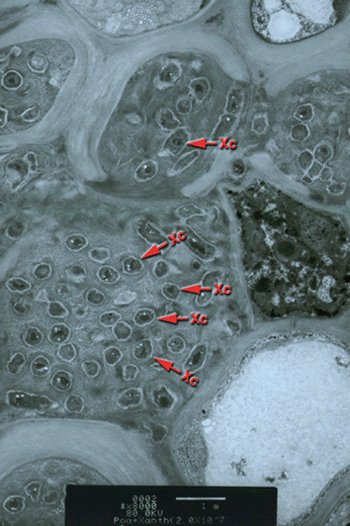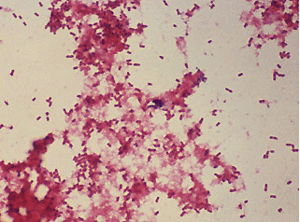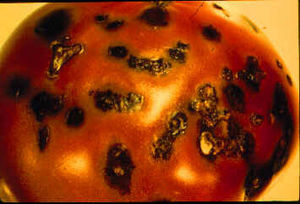Xanthomonas: Difference between revisions
m (→Pathology) |
|||
| Line 36: | Line 36: | ||
==Pathology== | ==Pathology== | ||
[[Image:diseasedplant. | [[Image:diseasedplant.gif|thumb|300px|left|''Xanthomonas fragariae'' affects strawberry plants, causing undesirable lesions on the fruit, making it unmarketable. From the [http://strawberry.ifas.ufl.edu/plantpathfiles/PP-angls-2full.htm University of Florida.]]] | ||
''Xanthomonas'' affects many types of hosts, including citrus, beans, grapes, cotton, and rice. ''X. axonopodis ''causes citrus cankers and black rot, which affects many commercial plants. Typical symptoms of the disease include lesions on the leaves, fruit, and stems as well as twig dieback (Cancer Annotation Project, 2002). | ''Xanthomonas'' affects many types of hosts, including citrus, beans, grapes, cotton, and rice. ''X. axonopodis ''causes citrus cankers and black rot, which affects many commercial plants. Typical symptoms of the disease include lesions on the leaves, fruit, and stems as well as twig dieback (Cancer Annotation Project, 2002). | ||
Revision as of 19:12, 12 June 2006
|
NCBI: |

Classification
Higher order taxa:
Bacteria; Proteobacteria; Gammaproteobacteria; Xanthomonadales; Xanthomonadaceae
Species:
Pseudomonas cissicola, X. albilineans, X. arboricola sp., X. axonopodis sp., X. bromi, X. campestris spp., X. cassavae, X. citri, X. codiaei, X. cucurbitae, X. cynarae, X. fragariae, X. gardneri, X. hortorum, X. hyacinthi, X. melonis, X. oryzae sp. , X. pisi, X. populi, X. sacchari, X. theicola, X. translucens sp., X. vasicola, X. vesicatoria, X. spp.
Description and Significance
Xanthomonas is a Gram-negative rod-shaped bacteria known for being a common plant pathogen.
Genome Structure
Xanthomonas bacteria are composed of a circular chromosome of about five mega bases. Each cell also contains two plasmids, with 34 and 65 kilobases. There appears to be a great deal of colinearity between X. axonopodis and X. campestris, leading to the conclusion that it may be that only three major rearrangement events have occured in the time separating them (BioMed, 2002).
Cell Structure and Metabolism

Xanthomonas is a flagellated, rod-shaped bacteria, which allows the bacteria to move throughout an infected plant. Xanthomonas is dependent on the type III protein secretion system, which relies on transport protiens, secreting several hypersensitive reaction proteins and outer proteins, causing an interaction with the plant (D.Büttner et al., 2002)
Ecology
Xanthomonas bacteria grow almost exclusively in plants. In São Paulo, Brazil, the numbers of citrus tress with citrus canker from Xanthomonas have grown at an astonishing rate. This has given the Brazilians no choice but to destroy not only the diseased trees, but trees within a 30m radius of the contaminated tree, putting the number of destroyed trees over 500,000 in 1998 alone (The Genome Project, 2004).
Pathology

Xanthomonas affects many types of hosts, including citrus, beans, grapes, cotton, and rice. X. axonopodis causes citrus cankers and black rot, which affects many commercial plants. Typical symptoms of the disease include lesions on the leaves, fruit, and stems as well as twig dieback (Cancer Annotation Project, 2002).

Symptoms of citrus canker, including small yellow lesions, can begin to appear as soon as only one week after the initial infection up to two months afterwards. Eventually, the initial yellow lesions turn brown and form a 'corky' surface, providing a method for later transmission to other plants and tissues (Genome Project, 2004).
References
General:
- Buddycom. 2004. Bacteria, gram negative bacilli.
- The Center for Integrated Plant Systems. 23 Nov 1998. Biological Control Program. Pathogens: Vargas.
- Büttner, D., D. Nennstiel, B. Klüsener, and U. Bonas. Institut für Genetik. 3 Feb 2002. Functional Analysis of HrpF, a Putative Type III Translocon Protein from Xanthomonas campestris pv. vesicatoria.
- The Genome Project. 2004. Xanthomomnas axonopodis.
Genome:
- BioMed Central. The Scientist. 28 May 2002. Comparing Xanthomonas.
Ecology:
- The Genome Project. 2004. Xanthomomnas axonopodis.
Pathology:
- Cancer Annotation Project. 16 Jul 2002. About Xanthomonas.
- The Genome Project. 2004. Xanthomomnas axonopodis.
- Tomato Diseases
- The University of Florida. 2000. Colletotrichum diseases of strawberry in Florida.
